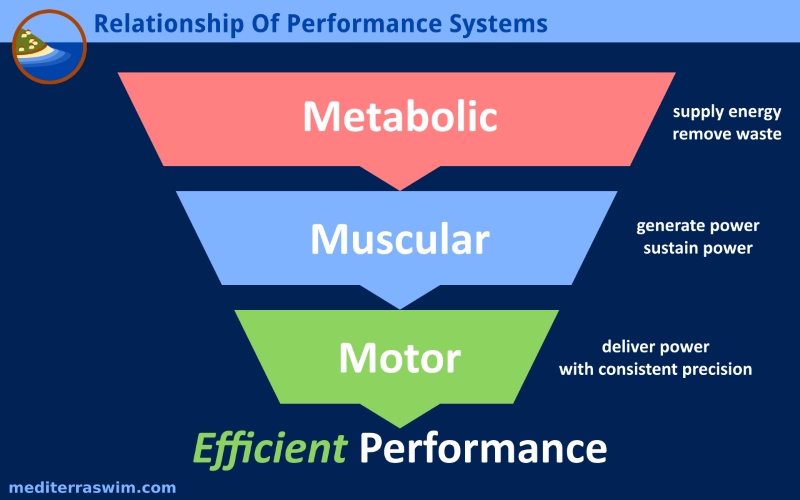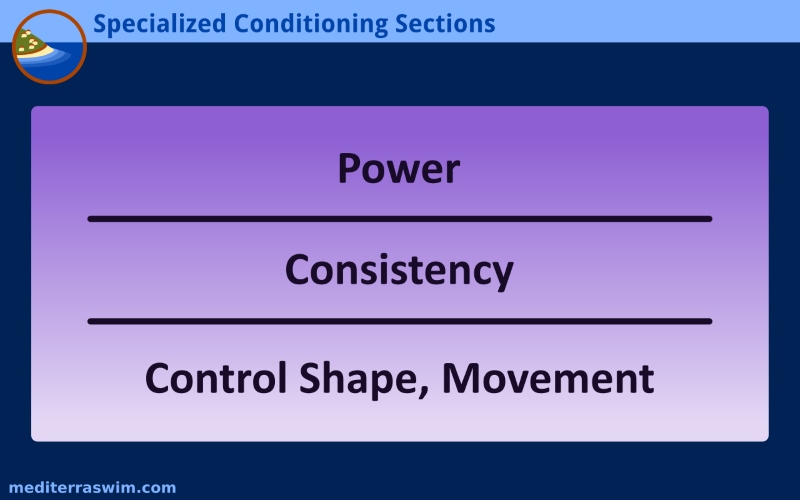Forums › Library › Knowledge Base › Stages Of Training
Please type your comments directly in the reply box - DO NOT copy/paste text from somewhere else into the reply boxes - this will also copy the code behind your copied text and publish that with your reply, making it impossible to read. Our apology for the inconvenience, but we don't see a convenient way of fixing this yet.
Tagged: metabolic system, motor system, muscular system, neural training, performance system, training process
-
AuthorPosts
-
July 15, 2018 at 15:07 #18999
Admin Mediterra
KeymasterIt may help to understand the physiological stages you will work through as you move from learning to swim (or learning to swim in a new way) to swimming much faster and farther with pleasing, efficient form.
We can describe your performance system as having these three parts that are inter-related:
- The motor (or neural) system
- The muscular system
- The metabolic system

They are shown in this order according to the order they appear in the process of movement.
Your metabolism supplies energy. Your muscles convert energy to power. Your motor (neural) system determines where, when and how much power the muscles will use.
In terms of priority, you must develop the motor system first – your body needs to learn how to move in the safest and strongest patterns for the specific activity (in your case, the specific activity is swimming freestyle or another stroke style).
While the neuromuscular system is being trained to move with precision, the specific arrangement of muscles are learning to move in the proper coordinated way, and developing strength that is very specific to that exact movement pattern.
Those working muscles are then demanding more energy from the metabolic system which is then provoked to improve its system for converting food to energy, supplying that to the muscles, and removing waste from the system.
Without precision, greater muscle power does not get you very far. Without muscle power, all the energy in the world does not move your forward. Though all three end up working together, in training them to get there, precision comes first, then muscle strength, then metabolic efficiency.
Order Of Training Emphasis
Your first goal is to be able to execute a few consecutive, precise strokes, to swim with control for a single length of the pool. Your next goal is to swim many continuous lengths of the pool with consistently precise strokes, up to 1000. Your next goal is to swim such distance (continuously, or broken into intervals) with such precision, at higher intensity, in terms of swimming faster and/or swimming longer distances.
Mind you, this use of the word ‘precision’ doesn’t mean ‘perfect’ – it just means executing the skill at a slightly higher standard than you were before. It means being more precise than you have been, and continually upholding that standard.
So, the general order of training emphasis is like this:
Train for control over shape and movement. Make the movement patterns precise. This targets the motor system, making it easier for your brain to send precise signals to your body parts and reliably produce the movement you intended.
Train the movements to be consistent. This targets muscular conditioning, provoking the muscles to become stronger around a very specific choreography.
Train the movements to be more powerful, more resilient over longer distance and in more intense conditions. This targets you metabolic conditioning, provoking the system to make more energy available.

Precision is the foundation upon which you build more efficient muscle strength (which is evidenced by consistency over distance) upon which you build more metabolic endurance. You can increase power and become more powerful in a way that actually moves your forward in the water, faster and farther, when you first invest the time in your motor/neural foundation.
The Training Process
You want to spend some weeks of frequent, deliberate training to build up a level of control in your shape and movement patterns. You are working toward being able to swim full lengths with a high level of precision on each stroke. You swim as slowly and in as short of repeats as needed to establish control and precision, then gradually speed up the movements and increase the repeat distance as you are able to maintain control and precision for individual lengths of the pool.
Then you spend some weeks or months building up consistency so that you are holding this shape and form for 100s of meters, from 25s to 100s to 400s to 1000s. You might count strokes, or you might use a Tempo Trainer to measure some aspects of consistency. This kind of work builds specific muscular strength around specific movement patterns.
Then you spend some weeks or months building up power by working with more challenging stroke length, tempo, pace.
How long do you spend on each of these? It depends on what your goal is and what your current condition is. Doing some test swims and consulting with your coach can provide you with some idea of what time frame you may work on this.
Though the length of time to work through these stages to your goal may not easily be estimated, the kind of work you need to do, and in what order is clear. Be patient and persistent to work through these stages. Human physiology is set up to develop this way, so you will do well to set your expectations to follow these.
Attachments:
You must be logged in to view attached files. -
AuthorPosts
- You must be logged in to reply to this topic.
